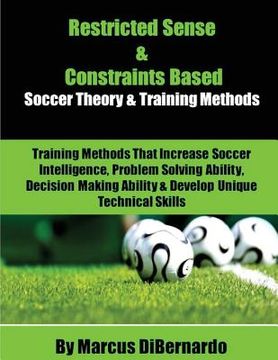Synopsis "Restricted Sense & Constraints Based: Theory & Training Methods (in English)"
"Constraint Based Training" and "Restricted Sense Training" are unique and highly effective approaches to coaching soccer. Developing high level players is not best accomplished using one narrative or by following a single linear pathway, players are more likely to flourish when they experience multiple learning environments. There is no coach-centered curriculum that progresses from point A to point Z, which is well-rounded enough to develop players to their highest potential. Each individual player is different and learns in their own unique way, trainings that offer many different types of learning experiences, while providing player's the opportunity to come up with numerous solutions to exercises are ideal, as these types of trainings will show developmental benefits over-time. The idea is for the exercise/training environment to become the teacher, the coach will have the freedom to interject, provide feedback or adjust the constraints to keep the experience challenging and flowing but ultimately the player is benefiting from exploring the learning environment, looking for ways to be successful. These types of training experiences develop the player's ability to make decisions and problem solve, in-effect increasing the players overall game intelligence. I know this might sound simple but creating these types of player centered trainings takes skill and planning. Coaches who use constraints effectively are able to guide and gently mold the player's learning experiences, instead of making themselves (the coach) the center of the learning experience. When a player is confronted with a constraint in training, it forces them to develop specific skills in order to adapt and be successful. One of the benefits of constraint based training is that the skills which are needed to be successful in one environment, can be transferred over to another environment, increasing overall performance levels. A good example of this would be the development of a players first touch who grows up playing on a bumpy, hard and unpredictable field. When that player finally gets to play on a perfect turf field, it will seem easy to control the ball with the first touch. Even beyond the first touch, the player will able to access different touches on the ball that players who played only on perfect fields may not have. The reality is that the players who grew up playing only on perfect fields will not have the same skills as players who consistently played on bumpy fields, the constraints posed by the bumpy fields, assist in specific skill development. Constraints don't just come in the form of fields though, constraints can be classified as individual, environmental or task related constraints, with many of the constraints intersecting and overlapping in the larger picture of the developmental process. Restricted Sense Training certainly overlaps the ideas of constraint training, but restricted sense training focuses specifically on adapting to the loss of auditory and visual information. The performance benefits associated with overcoming the loss of auditory and visual information are immense. Restricted sense training increases game intelligence by forcing players to develop alternative solutions to problems they would normally solve with full auditory and visual functioning. The restricted sense training methods are not one time experiments, in order for them to be successful, a longer term adaption of the methods must be applied.

